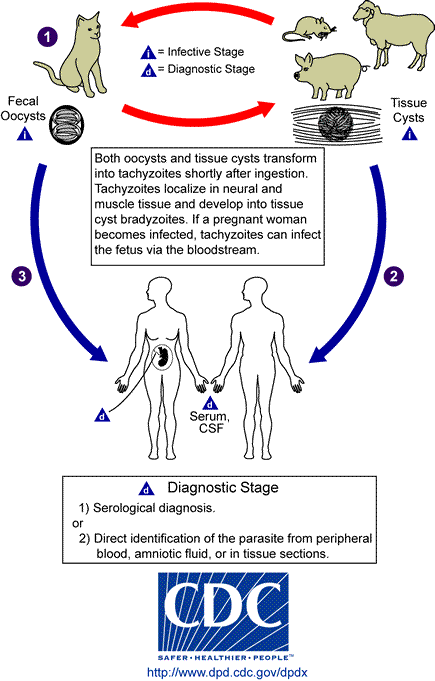|
The Companion Animal Parasite Council states: "Toxoplasmosis is one of the most important zoonotic parasites dealt with in veterinary medicine. It is caused by a two-host coccidian, Toxoplasma gondii, for which cats are the only known definitive hosts. " Seroprevalence of human infection in the United States is approximately 30-40%. Dogs can also get this disease.
Toxoplasmosis is acquired by ingesting the parasite after handling infective material such as cat feces, contaminated water, or contaminated dirt (gardening). Direct contact with a cat is not a known source of infection. You should feel comfortable living with a cat, but there are precautions that should be taken as detailed below.

Description: Members of the cat family (Felidae) are the only known definitive hosts for the sexual stages of T. gondii and thus are the main reservoirs of infection. Cats become infected with T. gondii by carnivorism (#1). After tissue cysts or oocysts are ingested by the cat, viable organisms are released and invade epithelial cells of the small intestine where they undergo an asexual followed by a sexual cycle and then form oocysts, which are excreted. The unsporulated oocyst takes 1 to 5 days after excretion to sporulate (become infective). Although cats shed oocysts for only 1 to 2 weeks, large numbers may be shed. Oocysts can survive in the environment for several months and are remarkably resistant to disinfectants, freezing, and drying, but are killed by heating to 70 C for 10 minutes. Human infection may be acquired in several ways: A) ingestion of undercooked infected meat containing Toxoplasma cysts (#2) ; B) ingestion of the oocyst from fecally contaminated hands or food (#3); C) organ transplantation or blood transfusion; D) transplacental transmission; E) accidental inoculation of tachyzoites. The parasites form tissue cysts, most commonly in skeletal muscle, myocardium, and brain; these cysts may remain throughout the life of the host.
There is no preventatives or vaccines available for this parasite, but there are preventative measures that can be taken to decrease the risk of zoonotic infection to dogs and humans. For cats, it is essential to eliminate exposure. Of greatest concern are pregnant women because this disease can cause devastating birth defects or death.
Daily cleaning of litterboxes is essential for eliminating exposure. Cat feces is the source of infection and must be handled with care. Immunocompromised, elderly, and pregnant individuals should not be cleaning the litterbox.
Keep cats indoors to prevent hunting activity. This parasite must be ingested from a contaminated host (mammal or avian) and become sexually active in the intestine of the cat.
Feed cats commercial diets. Do not feed cats raw or undercooked meat because this tissue may contain cysts that can become active after ingestion.
Wash hands regularly. Especially after handling cat feces or the litterbox.
While there is no approved treatment for this disease in dogs and cats, successful treatments are available.
|




